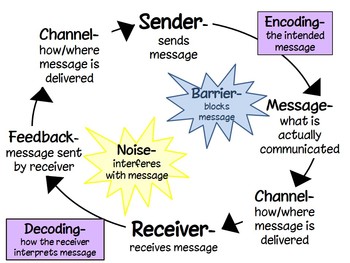Communication is a very basic process. To become an effective communicator however is a complex skill/art that few business leaders have mastered effectively.
Understanding the communication process is the first step to mastering the art of leadership communication.
As previously indicated, one can define communication in the workplace as being the multi-directional and multi-cultural transactions and interactions that occur within and between business people and/or companies. These exchanges have a job-related message as a core ingredient, whether the exchanges are local, global, interpersonal or electronic.
What distinguishes most communicators from skilful communicators is the latter’s ability to determine the frame of reference of the respondent/s and to relate the message in a manner that links up with the frame of reference of the communicator.
Let us consider the basic communication process:

The Source: The source (the leader) has a specific message that needs to be conveyed to the receiver. The source has the obligation to make the message to be conveyed clear, concise, correct and complete. By using symbols, gestures, pictures, tone of voice and words, the source encodes a message.
The Channel: The channel refers to the medium of communication that is used. Selecting the correct channel is essential in ensuring that the message will be received by the receiver. Communication channels include written-, verbal-, and visual communication. Utilising more than one of these channels at the same time increases the effectiveness of conveying the message.
The Receiver: The receiver (individual or group) needs to decode or translate the message sent by the source. The receiver will consider the gestures, words, symbols, etc. to understand and interpret the meaning of the message.
Feedback: Effective communication is always a two-way process. The source thus needs to check for understanding once the message was conveyed and the receiver needs to indicate how the message was understood and interpreted.
The process may seem simple enough, but unfortunately various factors may prevent the source and the receiver to share meaning and understanding.
Click here to view a video on the communication process.
The Sender/Source
Encoding your message through the words you use:
- “Politically correct communication.”
- Hot-button words, e.g. demanding words, such as “you have to…”; “you must…” or demeaning words like “that will never work...”; a stupid idea…”; ..failed...” or discriminatory language, like: “I only want to appoint a woman in her thirties with an MBA and who graduated from Wits” or potentially offensive language, such as swear words or “no” and “can’t”, which can stir up negative feelings.
- Worn-out words, e.g. hackneyed phrases like “work smarter, not harder” or buzz words such as “leading edge”, “paradigm shift”, “24/7”, etc.
Encoding your message through the non-verbal cues you use:
- Vocal cues, such as rate of speech, pitch-, volume-, and tone of voice.
- Facial expressions, head movements, gestures, posture, spatial relationship, dress and surroundings (e.g. neatness).
The Channel
This could be:
- Face-to-face (one-on-one, group meetings, etc.)
- Telephonic
- Letters
- Notice boards
- Memo’s
The Receiver
Frame of reference and perceptions.
Physical circumstances:
Noise barriers: physical noise, e.g. people talking, a noisy fan, telephones ringing or psychological noise, like distractions due to emotional problems or negative feelings towards the sender of the message.
In order to ensure effective communication between you, the leader and any other individual or team member, you need to pay careful attention to the way you encode your message, the channel or medium that you use and the disposition of the receivers of the message. Feedback is essential to ensure that shared meaning and understanding has been achieved, and to identify and eliminate any future barriers to effective communication. The leader thus needs to ensure congruence in both message and method.